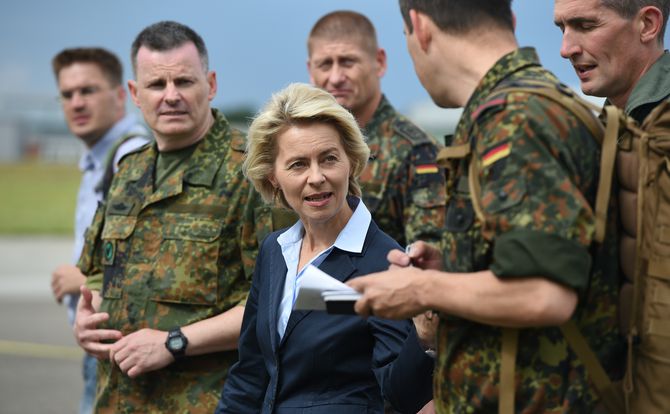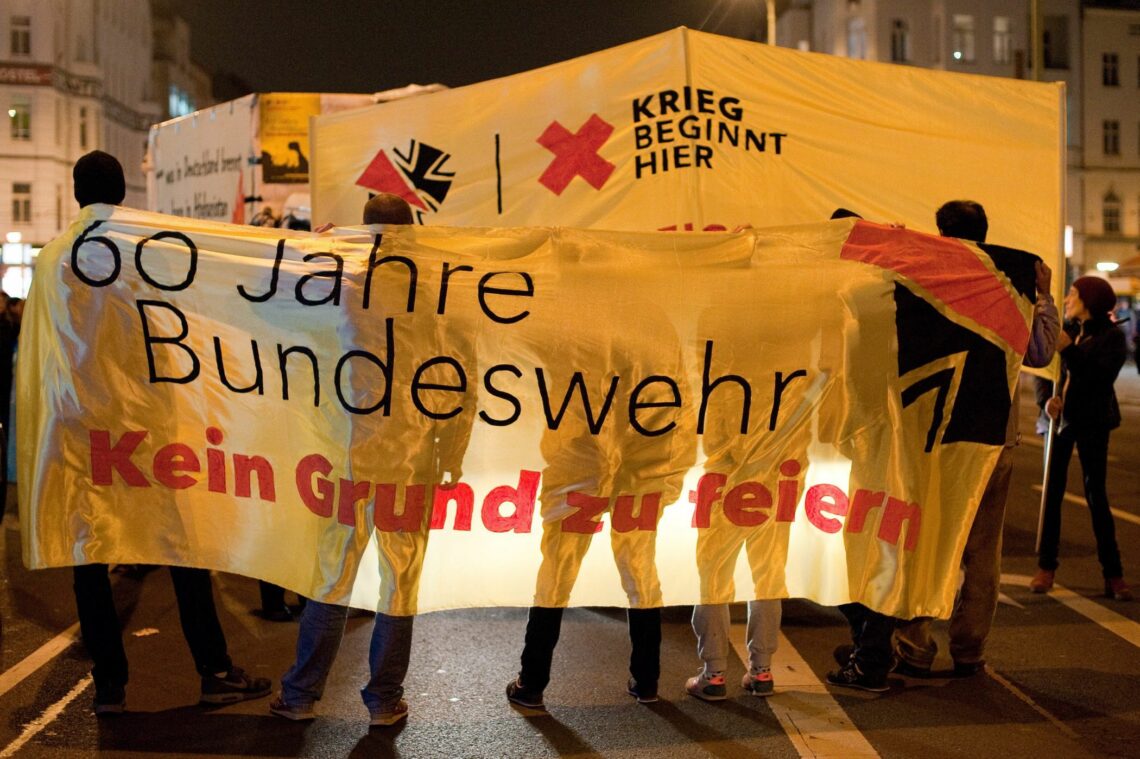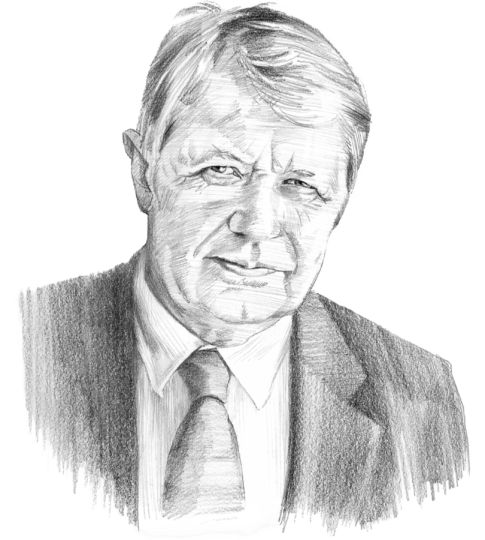Europe’s strategic future in global competition, Part 2
With responsibility for European security devolving onto individual countries, a question about Germany resurfaced. One proposed answer is the revival of a European Army, which would allow the German military to strengthen in a politically unthreatening way.

In a nutshell
- Calls for a European army run counter to the renationalizing trend in defense policy
- Only transformed, modernized militaries can cope with new operational requirements
- A wide range of potential conflicts put a premium on coordination and flexibility
- With NATO’s usefulness ebbing, the answer may be a core of empowered nations
The first part of this report examined how decision-making on Europe’s defense and security has increasingly devolved from multilateral structures to the national level. One result of this process has been to revive issues that dominated the European defense agenda in the early 1950s, albeit under different local and global circumstances. Then and now, a key question was what to do about Germany.
Back then, the United States, Great Britain and France all wanted German rearmament to bolster Europe’s defense against potential Soviet attack. They also agreed on the need for a supranational structure to integrate German forces, thus preventing them from coming under the control of national leaders. The former World War II allies disagreed, however, on what kind of structure was desirable.
France proposed a European Defense Community (EDC) as a core element of the continent’s broader political integration. While it was to be built into the North Atlantic alliance, France also saw Germany’s membership in the EDC as a way of keeping that country out of NATO. In other words, the French wanted to avoid forging a direct link between the U.S. and Germany.
History took a different turn. The EDC never became a viable structure. Ironically, France itself gave the death blow to the measure when the French National Assembly failed to ratify it in 1954 – just like the failed French referendum on the European Constitution in 2005 stopped the creation of a more robust European Union a half-century later.
EDU revived
Now, as a result of increasing U.S.-European tensions within NATO during the administration of President Donald Trump, and with the United Kingdom, one of Europe’s two leading military powers, on the verge of leaving the EU, the idea of a European Defense Union (EDU) has experienced a rebirth.
In the early 1950s, the UK pushed the EDU within a wider NATO framework, without seeing itself as a part of that European construct. Today, Britain’s military capabilities far exceed what the EU’s smallest 20 members can contribute to Europe’s collective defense. Yet the fact that the British can no longer block EU defense initiatives was enough to give the idea of a defense union new life. It resurfaces under different labels – European army, EU army or even what the new head of the European Commission, Ursula von der Leyen, has called an “Army of Europeans.”
NATO is no longer a rock-solid political structure in which Europe’s defense needs can be embedded.
While the original EDU of the early 1950s would have embraced only six members of what is now the EU, it is certainly worth dusting off the old institutional layout to see if certain elements might still fit.
Above all, it is worth noting that while NATO – even in its earliest stages – was a military organization constructed for defense against the Soviet threat, the EDU’s forces were not to be earmarked or tailored for use against a particular enemy.
One of the hallmarks of the present day is that Europe and the EU have long ceased to face any “clear and present danger” on the continent. At the same time, NATO is no longer a rock-solid political structure into which Europe’s defense needs can be embedded. Instead, European nations face a uniquely complicated situation. The political trend is toward renationalization, with most nations suffering from heavily polarized domestic politics and mainstream parties increasingly affected by populism. In the realm of defense and security, multilateralism is on the decline.
Germany without a framework
In the middle of all this, a new version of the German question is in the making. Robert Kagan observed that Germany’s commitment to NATO in recent years stems from its “continuing desire to remain unthreateningly anchored in Europe.” However, since the country could soon find itself “living in a largely renationalized Europe,” the American foreign policy specialist sensibly asked whether “the Germans under those circumstances resist a return to a nationalism of their own?”
To be sure, it would be hard to construct any plausible scenario in which Germany again poses an imperial threat to Europe. But the increasing influence of right-wing politics is already impinging on the debate over how to reform the Bundeswehr, with some advocating that it should be given more autonomy within the state. This emerging controversy will likely affect the broader political discourse over Germany and its future role in Europe.
That does not mean the issue will turn Germany into a European time bomb. But it could strengthen domestic opposition to bolstering German military capabilities and ensure that the Bundeswehr remains above all a parliamentarian army. Decades of military integration within NATO had avoided this possibility. Yet the resistance to building up the national armed forces fits well into the European army concept, which is now being pursued under the EU umbrella as a political project, with marginal military relevance.
The right’s growing influence could strengthen opposition to bolstering the German military.
European right-wing populists, including the Alternative for Germany (AfD), oppose the whole idea and favor a stronger, renationalized German military. The party had disguised this long-term ambition by endorsing NATO. Under the AfD’s vision, the alliance would continue to function in a less demanding form, acting as a framework for adopting standards and coordinating national force planning so that flexible coalitions can be built in case of a crisis.
The common thread running through these proposals is that NATO has ceased to be the primary political framework. For different reasons, support for the alliance is declining on both sides of the Atlantic. The U.S. is turning into an ever more distant NATO partner, yet it never liked the idea of a more independent European defense structure, either. The eagerness of France and Germany to use Brexit as an opportunity to through the EDU only worsens these centrifugal tendencies.
The British did indeed block defense-relative initiatives within the EU. But in light of Brexit and loosening bonds within NATO, it has become even more essential to build capacity for European defense that includes the UK, even if it is outside the EU framework. This option would be lost in any project modeled on the EDU, even if it is deemed useful for political integration (as Xavier Solana envisaged when he headed the Council of the EU in 1999-2009).
Toward external planning
All of these political considerations may turn out to be mere theatrics. Even so, the basic problems remain: European national forces must be modernized; more efficient ways must be found to coordinate the forces of the empowered European nations, including Britain; and all this must be done in a way that reassures the U.S. rather than driving a deeper wedge between Europe and its most important strategic partner.
Force planning for European militaries such as the Bundeswehr needs to consider readiness and future requirements over the long term, without making assumptions about enduring adversaries or stable coalition structures. Nations need to plan for their own forces, which would no longer be seen primarily in terms of their contributions to multilateral structures. This point is particularly important for the empowered nations, whose decisions will affect Europe’s regional and global competitiveness. It may be obvious to French and British policymakers but poses much more complex questions in a country like Germany.

As a standing force, the Bundeswehr must consider questions about its rationale and future ambitions in terms of operational capabilities. For limited global uses in the absence of a unified coalition strategy, the German military needs to be modernized and equipped to handle a variety of tasks, just like its counterparts in France and the UK. At the same time, the Bundeswehr will be an indispensable component in any broader military conflict that seriously involves Europe.
Quite likely, there will not be sufficient political support for a strong standing army. As a result, national military establishments should, above all, provide a professional cadre structure with the best possible equipment. These forces would then be filled out with reservists and reinforcements to be ready to respond flexibly in times of crisis, providing reassurance for partner nations. NATO would continue as one framework for this mobilization strategy of “reconstituting” a strong military force. For such a strategy to work, effective crisis management is needed – meaning that appropriate decision-making channels and action thresholds must also be established.
Regional postures
Europe’s armed forces will have to reckon with an increasingly challenging geopolitical environment without fixed enemies. One of the distinctive features of this new period will be coercive diplomacy. In contrast to the postwar period, which mostly observed an institutional separation of international trade and security issues, the two are now becoming increasingly intermingled, as economic warfare is substituted for military conflict.
This shift would relegate military power to a supporting role, backing up coercive diplomacy. It would mark the return to more assertive handling of European forces, requiring a careful strategic calculation of the likely post-conflict environment. A lower threshold for limited military action would go hand in hand with less dependence on nuclear deterrence. Paradoxically, this means the national defense will require more rigorous military planning than under NATO’s nuclear umbrella.
As with national economies, defense postures are increasingly oriented toward regionalization.
Like national economies, defense postures are increasingly oriented toward regionalization. As with economic and financial integration, the EU’s centralized policy of inclusion has driven integration as an end in itself. Within the wider EU, however, this has produced the opposite result: regions are drifting apart, separated between providers (net payers) and receivers, whether it be North vs. South or West vs. East.
In security, regionalization increasingly translated into organizational arrangements with their own group interests. Often these are defined by the different risk exposures of regions or subregions, whether it be the Mediterranean countries, the Visegrad Group, the Balkan nations, the Baltic states or countries with economic or security stakes in the Arctic. Especially for the nations on the EU’s outer rim, regional security is the dominant concern.
For the most part, these peripheral EU members are receivers of support from the empowered nations, or they seek such support by appealing to solidarity or suggesting a more generalized threat. Of course, potential security providers may have their own reasons for lending support. Within existing multilateral security structures, mutual commitments are much less binding and enforceable than they were during the era of East-West confrontation. However, some special spheres of interest remain – for example, the U.S. continues to be active in the Baltic region, while France plays much the same role in the Western Mediterranean.
Levels of engagement
If Europe’s defense strategy is to be reoriented toward outside threats, any preliminary geostrategic guidance should distinguish between four levels of military engagement:
- Peripheral conflict, involving EU border nations and partners
- Conflict within the continental strategic environment
- Conflicts involving Europe’s vital (e.g., economic) interests
- Conflicts involving global competitors with strategic leverage
In each case, the level of engagement corresponds to the expected power and depth of the potential aggression. In cases where the adversary has both escalation potential and strategic outreach, Europe’s more empowered nations will need to mobilize military resources and become involved in crisis management.
Conflicts with global competitors will still require close cooperation with the U.S.
At every stage of a potential conflict, political coordination of defense measures will involve a widening range of options and capabilities. This implies the need for command capabilities, organization and preparation, since different levels of engagement will involve coordination between regional defense clusters, authorities in charge of crisis management, military mobilization and reinforcement, and the direct involvement of empowered nations to provide a (nuclear) deterrent and escalation control.
Each level of engagement will affect European security and defense in profoundly different ways.
- Peripheral conflicts concern European subregions and will require local defense backed by escalation control, above all mobilization and reinforcement. Ground operations are likely to be dominant
- Conflict within Europe’s strategic environment would require rapid force projection, primarily via naval and air power
- Conflicts to ensure Europe’s global competitiveness and protect its international supply chains will require above all naval forces, supported by air and space capabilities. This would probably call for close cooperation with the empowered nations
- Conflicts involving global competitors are most likely to require close military cooperation with the U.S., although NATO may no longer provide a reliable framework for such coordination in the future
In short, first-level defense will involve above all regionally clustered forces. On the other three levels of engagement, Europe’s defense would be built around the empowered nations, with France, Great Britain and Germany as the core.
Back to basics
A European Security and Defense Council, containing all the empowered European nations – chiefly France, Great Britain and Germany – could become the ultimate coordinating institution at higher levels of engagement, backed by the U.S. within some NATO framework. Mobilization, force projection and escalation control would pose different challenges than during the Cold War. Above all, the different types of conflict (in geographical and temporal scale) will require more flexibility in response, forcing Europe to generate new, tailored procedures and capabilities.
Throughout this process, nations will remain the basic building blocks of Europe’s defense. The EU could grow into a stronger supporting role in defense, but it cannot supply command structures on its own. NATO is unlikely to disband, but it is also unsuited to prepare or coordinate purely European engagements.
In the decade ahead, Europe will need to answer the question posed by the great Raymond Aron: “What happens when there is no higher authority than that of states?” It will be up to Europe’s empowered nations to provide the answer.








